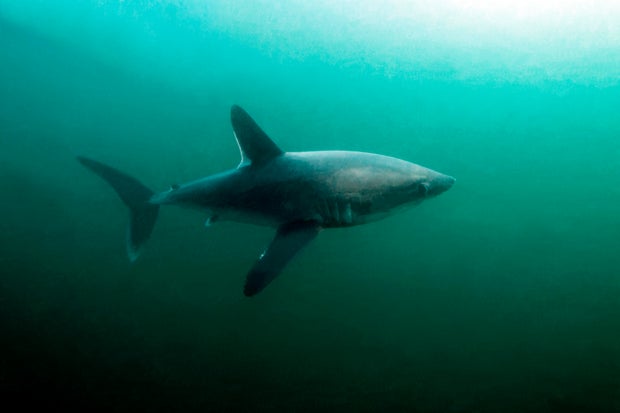In the ocean food chain, large sharks usually only have to worry about maintenance Orcas in the bay — but a new study suggests that ross hunters may be on their guard.
Researchers have uncovered evidence that the first known case of a porbeagle shark — which can grow up to 12 feet long and 500 pounds — was killed by a large shark hunter. The findings were published Tuesday in the biology journal Frontiers in Marine Science.
This is not the first case of “shark eating,” said John Dodd, executive director of the Atlantic Shark Institute, which helped lead the study. Bigger sharks eat smaller ones is a common occurrence, “In the open ocean, size matters, but there’s always something bigger.”
In some cases – bull shark, mako shark and baby sand tiger sharkFor example – sharks even eat their own species.
But cases of large sharks eating other large sharks, the subject of this study, are rare, said lead author Dr. Brooke Anderson, a marine biologist at the North Carolina Department of Environmental Quality.
The death of the female porbeagle raises the question of whether the incident is indicative of a broader trend among large predators, Anderson said. “With advances in technology, it’s possible that this happens more often than we’ve actually discovered,” Anderson said.
It’s impossible to count the number of sharks eaten by other sharks, Dodd said, but if our experiences at the Atlantic Shark Institute are any indication, it may be more than we think.
A group of scientific researchers from across the United States discovered the fish die-off while conducting a satellite tracking project in the northwest Atlantic Ocean to better understand the location, behavior and environmental preferences of shark species. They were particularly curious about female porbeagles, which are known to cross long stretches of ocean to give birth to their pups.
“We were really looking to understand the habitats used by pregnant females and try to understand where they might give birth,” Anderson said.
The victim, named Penelope by researchers, was one of 11 sharks tagged off the coast of Cape Cod in 2020 and 2022. Tracking tags were placed on the sharks’ dorsal fins and used to collect information about depth and water depth. The temperature tags stored data until they finally fell off the sharks, at which point the data was transmitted to researchers via satellite.
Gerard Suri/Getty Images
The trackers were designed to stay on for a year, but five months into the experiment, Penelope’s data was already logged. “As soon as I got the data from that tag, I immediately realized something strange was going on,” Anderson said.
A few days before Penelope’s tag came out on the Bermuda beach, the water temp Suddenly he nailed it. Even when it reached 600 meters below sea level, it remained relatively high, which is “very unusual,” Anderson explained.
Anderson and his colleagues came to a shocking conclusion: another sea giant had been hunted and eaten by another sea giant. “The only explanation for this data is that the tab is now in the stomach of a predator,” Anderson told CBS News.
The researchers don’t know with 100% certainty what the culprit was, but the predator’s diving pattern that the researchers tracked by looking at the depth data collected by the tag was similar to white sharks they’ve tracked in the past. . “Based on that, I’m guessing it’s a mature female white shark,” Anderson said.
Historically overfished, porbeagles are considered endangered in certain areas of the world. Given that they are already at risk, losing pregnant women and their babies can be devastating for people, Anderson said.
And sharks aren’t the only ones who could feel the ripple effects of this change. Benthic rulers maintain the balance of the underwater ecosystem by controlling smaller predator populations and adding vital nutrients to the shallow waters.
“Humans rely heavily on the oceans for food and many other things, and the oceans need healthy shark populations,” Anderson said.
#shark #eats #sharks #Researchers #evidence #large #sharks #prey
